

Destinations
Experiences
 |
L A
D A T C O T O U R
S |
 |
||||||||
| HOME | South America | Falkland Islands | Antarctica | Unique Destinations |
Unique Experiences |
Newsstand | ||||
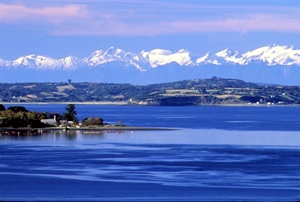 |
Chiloe Island Chile ANCUD: Hosteria Ancud |
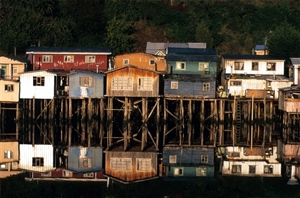 |
|
New York Times January 6, 2012 included Chiloe in "45 Places to go in 2012" article |
|
|
|
In the words of
chiloeweb.com: About Chiloe: Geography and Demography |
|
Chiloé: architecture Wooden architecture has developed in Chiloé along two distinct lines. The first is associated with Spanish settlers of the 16th century. Though there are no documents of the period some have survived from the 18th century and aid our understanding of earlier periods. The second line of development is that brought by German colonists of the mid 19th century. These two strong heritages have been fused to the enrichment of both. As a result the architecture is vernacular in character and gives expression to the culture of the islands and personality of the builder. The structural form of Chilote churches and chapels is very simple. Despite common bonds there is also a rich diversity of facades, Records from 1770 show that the houses of Castro, Chacao and the countryside all were built of weatherboard with thatched roofs (though a few were roofed with board). Thatched roofs, providing good insulation and protection from the weather, were part of the Mapuche culture. It is still possible to see a few examples in the islands of Quinchao and Lemuy. At the end of the 19th and beginning of the 20th century the ports had intense commercial activity and constructed buildings representative of the strong northern European influence. |
|
PALAFITOS: The
buildings are raised on poles in the water. Though it is not original to Chiloé the style
has been adopted in Ancud, Quemchi, Castro, Chonchi and other ports. Their construction
was stimulated by the large amount of waterborne traffic in the 19th century. Only a few
remain today, primarily in Castro. The style developed local characteristics, especially
at the front where the living space was extended with balconies and characteristic window
forms. With their shingled exteriors the Palafitos have a delightful appearance which has
been strongly influenced by the traditional textile designs known to Chilote craftsmen. |
|||
|
TEJUELA (Shingle
construction): Shingles were rarely used in the colonial period, they came into
fashion with the arrival of German settlers in the areas of Llanquihue and Puerto Montt,
who used them to give grace and elegance to their constructions. The shingles are cut from
the timber of the alerce and are thin, wide and long, they are lapped one over another to
prevent the ingress of rain leaving only a third of their length in view. The overall
effect depends upon the shapes into which the shingles have been cut. Original dimensions
were 90 cm long, 15 cm wide and 1 cm thick nowadays they are a little smaller. Chiloé is a paradise for crafts and craft workers. Textiles come
from thousands of rural weavers who also produce basket ware for fishermen, farmers and
the home. Working by hand, craftsmen cut housing shingles and boat building timbers.
Stonemasons carve useful implements for the home. Chilotes and tourists can buy handcrafts
in the markets; the most important of which is in Dalcahue every Sunday morning. There are
other markets in Ancud, Castro and Achao. |
|||
|
Chiloé: Flora and Fauna Thanks to being an island Chiloé has evolved a rich biology that impressed Charles Darwin in the 19th century. The exuberant natural life stems from millions of years ago with a great variety of flora and fauna including Marsupials like kangaroos, araucarias trees and coigües that evolved in isolation. The 443 species of flora are grouped into 205 genera and 96 families. In other words there are relatively few individual species within each biological grouping. For instance among the trees 26 genera (81%) have only one endemic species. This is evidence for the long isolation experienced by the temperate forests of Chiloé. The fauna is very similar: 50% of the freshwater fish, 76% of amphibians, 33% of mammals and 30% of birds are endemic to these temperate forests. An example being the monito del monte, an endemic species that is the only representative of the Microbiotheria, an ancestral branch of the marsupials. In conclusion the singular characteristics of our southern forests, their high number of endemic species and the dominance of flowering plants rather than conifers as in similar forests in the northern hemisphere (in Chile all the species of pine have been introduced) is a result of the island's origin in Gondwanaland and prolonged isolation. (From: El Bosque Chilote – Defensores del Bosque chileno, 1999) |
|||
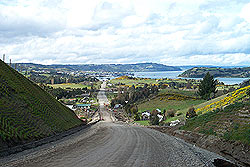 Dalcahue |
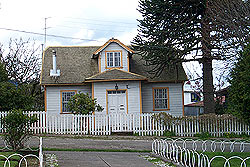 Dalcahue |
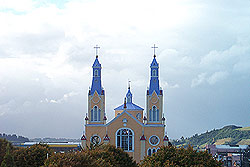 Castro |
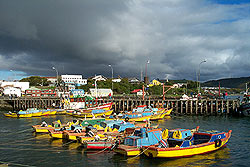 Ancud |
ANCUD COMMUNITY
Ancud is the front door to Chiloé for most visitors. It boasts a magnificent location and
many attractions. The town's site was choosen by Carlos de Beranguer for defensive
reasons. He concentrated troops in San Carlos, moved in people from Chacao and provided a
safe haven for the people of Castro. The new port became a centre for costal trade with
Lima. Until quite recently the ocean was the Chilotes principle means of communication
with the outside world. Ancud is one of the main centres of population for Chiloé.
CASTRO AND ENVIRONS
Castro was the Spanish Provincial capital until 1788, when Ancud replaced it. Little by
little it regained importance as a centre for the archipelago and eventually reclaimed its
status as capital. After surviving great earthquakes, such as the one of 1960, and
devastating fires, Castro has emerged as a major business and tourist centre. It is a main
departure point for exploring the archipelago. Visiting the northern part of the town, one
sees the traditional "Palafitos". Public buildings, shops and restaurants
surround the Plaza de Armas, in the centre of town. Calle Blanco leads down to the port
which is full of vessels arriving from the islands and coastal communities, carrying
passengers, farm produce and hand crafts to the markets.
DALCAHUE AND ENVIRONS
Dalcahue is an important hub for communications and commerce amongst the nearby islands
coast. Since the 19th century the port of Dalcahue has been a staging post. A fair is held
here every Sunday where craftsmen and people from surrounding islands and towns gather
together to buy and sell their wares. Everybody seems to land up in Dalcahue. Launches
bring people from the Chauques islands, from the archipelago of Quinchao and from all the
coastal areas of Quicaví, Tenaún, Tocoihue, Calen, San Juan, Quetalco and islands
further afield. In recent years the area has modernised its agricultural and maritime
economy. Major businesses have invested in the marine sector resulting in a rapid growth
of road transport and related activities.
CHONCHI AND ENVIRONS
Chiloé National Park is one of the major attractions in the area, it is reached via the
lakeside villages of Huillinco and Cucao with their picturesque cemeteries. In Chonchi,
where the buildings were constructed in timber, the community reached its apogee at the
end of the 19th century due to cattle raising and timber extraction. Particularly
significant are the "corner houses" and 19th century buildings that have
survived the passing of centuries and the earthquake and tidal wave of 1960. Chonchi is
the area capital and an important port for new aquaculture industries. Los Petanes, Notué
and Quiao provide facilities for "aquatourism" and demonstrate the strong
relationship of the country people with the surrounding sea. Sport fishing is developing
rapidly in the numerous rivers and lakes of the area.